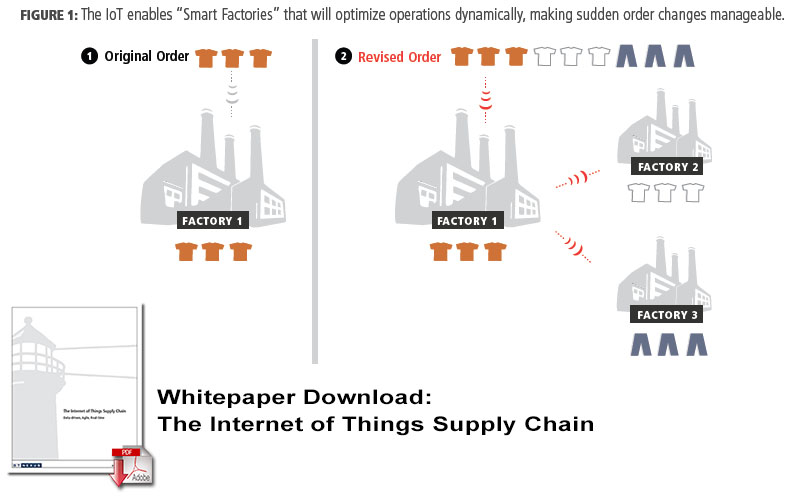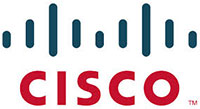Internet of Things and the Supply Chain: The Complexity of Staying Connected

The tech world is abuzz with how the Internet of Things (IoT) will change everything - usually for the better; it could be the dawn of incredible connectivity, speed and efficiency.
While consumers need only concern themselves with what new gadgets and toys they can connect, manufacturers have a long road ahead.
All of these changes don’t just mean cost-cutting and heightened visibility; they mean unparalleled complexity. Not only will forward-thinking companies thrive, those who can’t jump on quickly will be fighting against the current.
Success stories like General Electric highlight the difference between companies of the past, and the future. For over a century, GE was known for selling industrial hardwares and services. The name GE does not, at first, inspire thoughts of new software, cloud computing or other hot trending buzzwords.
Rather than waiting for the future to render them obsolete, GE reinvented themselves using the industrial internet, and transformed their business by relying on sensors and the IoT. They went from one of the most “physical” entities imaginable, to a data-based company. As described in a white paper from GT Nexus, “every company will need to become, to some extent, a technology company.” Of course, utilizing IoT does not end at slapping RFID tags on some products. Companies of the future will have to completely redefine their business, and cut out any legacy thinking.
The Real Cost of Connectivity
With estimates from Cisco that, by 2020, there will be “more than 50 billion devices connected to the Internet,” only 17% of which will be computers, there is no doubt that the IoT will consume just about everything. Moreover, studies repeatedly show that one of the most important IoT fields will be in Logistics and the Supply Chain. In fact, the same Cisco study estimates the fields will make up $1.9 trillion at stake in IoT’s future.
As technology develops and companies adapt, consumer demand for speed and customization will sky rocket. Manufacturers will be forced to operate at an exceptional level and be ready to change and modify operations in real-time, or risk falling behind. Rutgers’ Business School will even begin offering an accelerated certificate program specifically on the Supply Chain in a Digitalized Network later this year.

In pop culture, the IoT sounds like the final frontier, especially for businessmen. It offers superb optimization of processes, detailed tracking of goods and supply chain analysis, as well as transparency and new business models. Manufacturers can know the exact status of every piece, parcel and person; they can actively monitor assets and make quick, effective changes.
Automated processes means lower costs, and incredible optimization—theoretically. However, it is not only paramount that companies fully embrace the changing climate, they must prepare for the shift beforehand. IoT will bring about at least two major shifts for supply chains and logistics. First, mass production will become a buyers’ market. Per-unit and specialized shipments will become normalized. Second, exceptional micro-logistics will become vital in order to achieve full speed, efficiency and consumer satisfaction.
The first point speaks to the fun, trendy IoT that gets even non-techies excited. Imagine a factory room covered in sensors, each speaking to each other; it’s the factory of the future. Each item is a specially created building block. They can monitor and track themselves. They even act autonomously, while simultaneously contributing to the whole. The atmosphere and system will be oriented around decentralized decision making. Each smart unit will be expected to make decisions—sounds a bit dangerous, doesn’t it? If not done properly, it would be a very precarious system.
To make things worse, “micro-logistics” really does refer to the smallest “micro” possible. Every speck in the chain must work properly. The lack of common standards and a frustrating skill gap means implementing these dreamy space-age solutions is not going to be normalized for some years to come. Finally, once all of these technologies are connected, the real battle begins. Lighting up dark assets, data that had never been collected, a realistic process must be in place to analyze it. Not all manufacturers are big data experts. Insights gleaned from smart forklifts, smart boxes and even smart lighting are not just useless but detrimental to a company that isn’t designed to deal with them.
A paper from Bosch’s Software Innovations division sheds some light on another aspect of the connected fleet and supply chain. Namely, how can vehicles all over the country—and world—be effectively connected? What if a truck drives through a particularly winding stretch of mountain road? Or, more generally, if there is any kind of disruption. Losing connection is simply not an option for these huge programs. Plus, connections must always be secure. IoT always includes questions of security, and companies will have to deal with this on a new scale. Unfortunately, companies can hardly build a private wide-spread infrastructure. Bosch suggests IoT carriers partner with network providers. This could enable all types of communication management, and perhaps lead to specialized tariffs and resources for manufacturers.
Lastly, presuming that companies can get a handle on the unwieldy new technologies, relationships between businesses are going to change. Currently, logistics is an incredibly fragmented industry. There are countless suppliers working at all kinds of speeds and standards. From the local to the international level, processes can be a bit of a mess. They are not the streamlined, connected operations necessary for good IoT-based logistics. Logistics is about networking and finding the best route as quickly as possible. This is only possible when companies are connected inside and out.
Finding Success within the Mega-trend
Despite the many hurdles, IoT will reinvent the supply chain and logistics. It has already begun. With major companies like Whirlpool and General Motors on the bandwagon, it’s clear there is no stopping the mega-trend from taking over. There are already success stories emerging, like GE. Start-ups and smaller companies seem to be taking a shine to the IoT technology must more quickly. From specializing in helping companies transition, to using IoT in small doses to up productivity, the trend is clearly profitable, and popular.
The integration of the IoT into the supply chain will no doubt lead to many interesting stories, raising the question of who will adapt, and who will fall behind.
Article Source: DATACONOMY
Related: 3 Ways the IoT Will Transform Manufacturing Processes

Article Topics
Cisco News & Resources
The Rebound Podcast: Supply chain management for the circular economy The Rebound: Supply Chain Management for the Circular Economy Gartner announces rankings of the 2017 Supply Chain Top 25 U.S. Dept. of Commerce Partners with USC Marshall Center to Advance Nation’s Supply Chain Seaport of the Future - Optimizing and Securing Cargo Movement 2016 State of ERP: Gaining Speed Modex: Keynote presents connected supply chain benefits More CiscoLatest in Technology
Biden Gives Samsung $6.4 Billion For Texas Semiconductor Plants Apple Overtaken as World’s Largest Phone Seller Walmart Unleashes Autonomous Lift Trucks at Four High-Tech DCs Talking Supply Chain: Procurement and the AI revolution 80% of Companies Still Unsure How to Best Leverage AI, Study Finds Supply Chain Stability Index: “Tremendous Improvement” in 2023 AI Not a Priority for Retailers and CPG Companies More Technology














